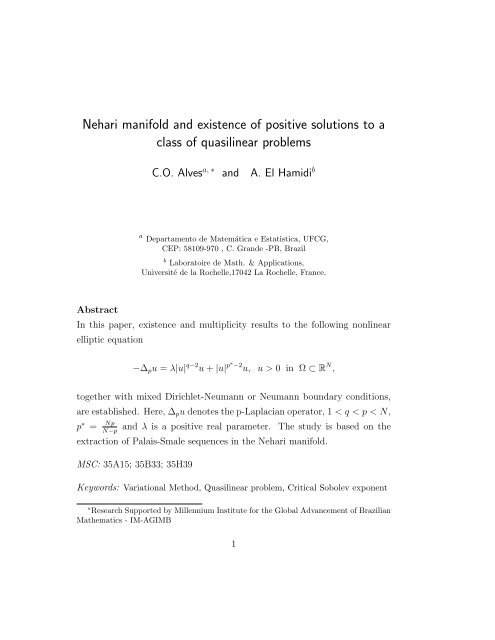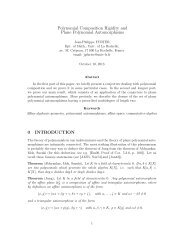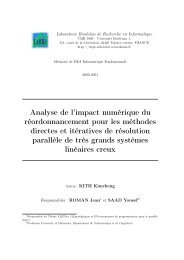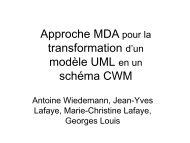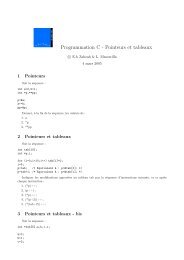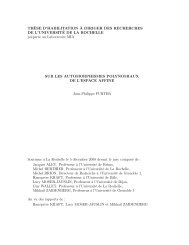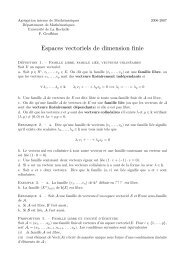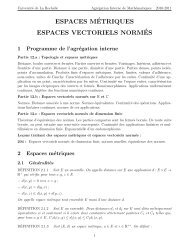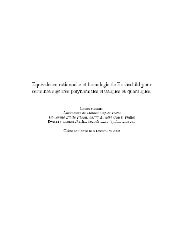Nehari manifold and existence of positive solutions to a class of ...
Nehari manifold and existence of positive solutions to a class of ...
Nehari manifold and existence of positive solutions to a class of ...
You also want an ePaper? Increase the reach of your titles
YUMPU automatically turns print PDFs into web optimized ePapers that Google loves.
<strong>Nehari</strong> <strong>manifold</strong> <strong>and</strong> <strong>existence</strong> <strong>of</strong> <strong>positive</strong> <strong>solutions</strong> <strong>to</strong> a<strong>class</strong> <strong>of</strong> quasilinear problemsC.O. Alves a, ∗ <strong>and</strong> A. El Hamidi ba Departamen<strong>to</strong> de Matemática e Estatistica, UFCG,CEP: 58109-970 , C. Gr<strong>and</strong>e -PB, Brazilb Labora<strong>to</strong>ire de Math. & Applications,Université de la Rochelle,17042 La Rochelle, France.AbstractIn this paper, <strong>existence</strong> <strong>and</strong> multiplicity results <strong>to</strong> the following nonlinearelliptic equation−∆ p u = λ|u| q−2 u + |u| p∗ −2 u, u > 0 in Ω ⊂ R N ,<strong>to</strong>gether with mixed Dirichlet-Neumann or Neumann boundary conditions,are established. Here, ∆ p u denotes the p-Laplacian opera<strong>to</strong>r, 1 < q < p < N,p ∗ =NpN−p<strong>and</strong> λ is a <strong>positive</strong> real parameter. The study is based on theextraction <strong>of</strong> Palais-Smale sequences in the <strong>Nehari</strong> <strong>manifold</strong>.MSC: 35A15; 35B33; 35H39Keywords: Variational Method, Quasilinear problem, Critical Sobolev exponent∗ Research Supported by Millennium Institute for the Global Advancement <strong>of</strong> BrazilianMathematics - IM-AGIMB1
2 Alves <strong>and</strong> El Hamidi1 IntroductionIn this paper, we deal with the <strong>existence</strong> <strong>of</strong> multiple <strong>solutions</strong> <strong>to</strong> the boundaryvalue problems⎧⎨⎩⎧⎨⎩−∆ p u = λ|u| q−2 u + |u| p∗−2 u in Ω,u = 0 on Γ,(1.1)∂u∂ν on Σ,−∆ p u = λ|u| q−2 u + |u| p∗ −2 u in Ω,p−2 ∂u|∇u| = ∂ν −a(x)|u|p−2 uon ∂Ω,(1.2)with respect <strong>to</strong> the real parameter λ. Here, Ω is a bounded domain in R Nwith smooth boundary ∂Ω = Γ∪Σ, where Γ, Σ are smooth (N-1)-dimensionalsub<strong>manifold</strong>s <strong>of</strong> ∂Ω with <strong>positive</strong> measures such that Γ ∩ Σ = ∅, ∆ p is the∂p-Laplacian, is the outer normal derivative, <strong>and</strong> ∂νp∗ = Np . ThroughoutN−pthis paper, the function a is assumed <strong>to</strong> be in L ∞ (∂Ω), a(s) ≥ a 0 > 0 almosteverywhere on a subset <strong>of</strong> ∂Ω with <strong>positive</strong> measure.In a recent paper, K. J. Brown & Y. Zhang [6] have studied a subcriticalsemilinear elliptic equation with a sign-changing weight function <strong>and</strong> abifurcation real parameter in the case p = 2 <strong>and</strong> Dirichlet boundaryconditions.Exploiting the relationship between the <strong>Nehari</strong> <strong>manifold</strong> <strong>and</strong>fibering maps (i.e., maps <strong>of</strong> the form t ↦→ J λ (tu) where J λ is the Euler functionassociated with the equation), they gave an interesting explanation <strong>of</strong> a wellknown bifurcation result. In fact, the nature <strong>of</strong> the <strong>Nehari</strong> <strong>manifold</strong> changesas the parameter λ crosses the bifurcation value. In Tarantello [16], usingthe same type <strong>of</strong> approach the critical case has been studied also assumingp = 2, q = 2 <strong>and</strong> Neumann boundary conditions.In this work, we exploit similar facts <strong>to</strong> show the <strong>existence</strong> <strong>of</strong> multiplenontrivial <strong>positive</strong> <strong>solutions</strong> <strong>to</strong> (1.1) <strong>and</strong> (1.2). The idea <strong>of</strong> our approach canbe summarized as follows: Let I λ (resp. J λ ) the Euler functional associated <strong>to</strong>Problem (1.1) (resp. Problem (1.2)) defined on W 1,pΓ(Ω) (resp. on W 1,p (Ω)),
<strong>Nehari</strong> <strong>manifold</strong> <strong>and</strong> <strong>existence</strong> <strong>of</strong> <strong>positive</strong> <strong>solutions</strong> 3whereW 1,pΓ (Ω) = {u ∈ W 1,p (Ω); u| Γ = 0}is the closure <strong>of</strong> C 1 0(Ω ∪ Γ) with respect <strong>to</strong> the norm <strong>of</strong> W 1,p (Ω) (we refer thereader <strong>to</strong> the paper by Colorado & Peral [8] for a complete study in the casep = 2).For each u ∈ W 1,pΓ(Ω) \ {0} (resp. W 1,p (Ω) \ {0}) λ > 0, we determine thereal values <strong>of</strong> t (in terms <strong>of</strong> u <strong>and</strong> λ) such that tu belongs <strong>to</strong> the <strong>Nehari</strong><strong>manifold</strong>:N Iλ = { v ∈ W 1,pΓ (Ω) \ {0} : I′ λ(v)(v) = 0 }(resp. N Jλ = { v ∈ W 1,p (Ω) \ {0} : J ′ λ(v)(v) = 0 } ).Then, the variable t is substituted by these special values <strong>to</strong> obtain newEuler functionals defined on the <strong>Nehari</strong> <strong>manifold</strong>. On shows easily that thesefunctionals are bounded below, which allows <strong>to</strong> find possible critical points byminimization. Moreover, this approach allows the simultaneous construction<strong>of</strong> Palais-Smale sequences, in the <strong>Nehari</strong> <strong>manifold</strong>, giving directly <strong>existence</strong><strong>and</strong> multiplicity results [10].Let us mention that in the case p = 2 <strong>and</strong> with a subcritical concaveconvexnonlinearity, this problem was studied recently by Colorado & Peral[8]. The authors showed that there is a special value Λ <strong>of</strong> the parameter λsuch that Problem (1.1) admits at least two <strong>positive</strong> <strong>solutions</strong> for λ ∈ (0, Λ),admits at least one <strong>positive</strong> solution for λ = Λ <strong>and</strong> admits no <strong>positive</strong> solutionfor λ > Λ.In our opinion, an interesting question which is not treatedin our paper, is <strong>to</strong> characterize Λ as a bifurcation value via the dynamic<strong>of</strong> the <strong>Nehari</strong> <strong>manifold</strong> with respect <strong>to</strong> the parameter λ (see [6]).Someresults involving the p-Laplacian opera<strong>to</strong>r, concave-convex nonlinearity <strong>and</strong>Dirichlet boundary conditions can be found in the papers <strong>of</strong> Garcia Azorero& Peral Alonso [11] <strong>and</strong> Ambrosetti, Garcia Azorero & Peral Alonso [4].This paper is organized as follows: Section 2 is devoted <strong>to</strong> Problem (1.1)<strong>and</strong> Section 3 is the subject <strong>of</strong> Problem (1.2).
4 Alves <strong>and</strong> El Hamidi2 The mixed Dirichlet-Neumann Problem(1.1)It is well known that weak <strong>solutions</strong> <strong>of</strong> (1.1) correspond <strong>to</strong> critical points <strong>of</strong>the C 1 functional I λ : W 1,p (Ω) −→ R, given bywhere∫P (u) =ΩΓI λ (u) = 1 p P (u) − λ q Q(u) − 1 p ∗ P ∗ (u),∫|∇u| p dx, Q(u) =Ω∫|u| q dx <strong>and</strong> P ∗ (u) =Ω|u| p∗ dx.Using the fact that Γ has strictly <strong>positive</strong> measure, the Poincaré inequality isstill available in the space W 1,p (Ω), hence it can endowed with the followingnormΓ‖u‖ ={ ∫ |∇u| p dxΩ(see some commentaries in Kesavan’s book [12, page 125], for the case p=2).In the sequel, || ||, || || q <strong>and</strong> || || p ∗ will denote the norms on W 1,pΓ(Ω), Lq (Ω)<strong>and</strong> L p∗ (Ω) respectively. We introduce the modified functional Ĩλ defined onR × W 1,pΓ (Ω) by Ĩλ(t, u) := I λ (tu), (see [19, 9, 10]). For every u ∈ W 1,pΓ(Ω),∂ t Ĩ λ (., u) (resp. ∂ tt Ĩ λ (., u)) is the first (resp. second) derivative <strong>of</strong> the realvalued function: t ↦→ Ĩλ(t, u).2.1 Preliminary resultsSince the functional Ĩλ is even in t <strong>and</strong> that we are interested by the nontrivial<strong>solutions</strong> <strong>of</strong> (1.1), we limit our study for t > 0 <strong>and</strong> u ∈ W 1,pΓ(Ω) \ {0}.Lemma 2.1 For every u ∈ W 1,p (Ω) \ {0}, there is a unique λ(u) > 0 suchΓ} 1p,that the real valued function t ↦→ ∂ t Ĩ λ (t, u) has exactly two <strong>positive</strong> zeros(resp. one <strong>positive</strong> zero) if 0 < λ < λ(u) (resp. λ = λ(u)). This functionhas no zero for λ > λ(u).
<strong>Nehari</strong> <strong>manifold</strong> <strong>and</strong> <strong>existence</strong> <strong>of</strong> <strong>positive</strong> <strong>solutions</strong> 5Pro<strong>of</strong>. Let u be an arbitrary element <strong>of</strong> W 1,pΓ(Ω) \ {0} <strong>and</strong> let us write∂ t Ĩ λ (t, u) = t q−1 H λ (t, u), where H λ (t, u) = t p−q P (u) − λQ(u) − t p∗ −q P ∗ (u).Then∂ tt Ĩ λ (t, u) = (q − 1)t q−2 H λ (t, u) + t q−1 ∂ t H λ (t, u),holds true, with∂ t H λ (t, u) = t p−q−1 { (p − q)P (u) − (p ∗ − q)t p∗ −p P ∗ (u) } .The real valued function H λ (., u) is increasing on (0, t(u)), decreasing on(t(u), +∞) <strong>and</strong> attains its unique maximum for t = t(u), wheret(u) =( ) 1p − q P (u)p ∗ −p. (2.3)p ∗ − q P ∗ (u)Thus, the function H λ (., u) has two <strong>positive</strong> zeros (resp. one <strong>positive</strong> zero) ifH λ (t(u), u) > 0 (resp. if H λ (t(u), u) = 0) <strong>and</strong> has no zero if H λ (t(u), u) < 0.On the other h<strong>and</strong>, a direct computation givesH λ (t(u), u) = p∗ − pp − qSimilarly, H λ (t(u), u) > 0 (resp.λ > λ(u)) <strong>and</strong> H λ(u) (t(u), u) = 0, wherewithλ(u) = Θ( ) p ∗ −qp − q P (u)p ∗ −pP ∗ (u) − λQ(u).p ∗ − q P ∗ (u)Θ = p∗ − pp − qH λ (t(u), u) < 0) if λ < λ(u) (resp.Pp∗ −qp ∗ −p (u), (2.4)Q(u) P ∗ p−qp ∗ −p (u)( ) p ∗ −qp − qp ∗ −p.p ∗ − qIt follows that if λ ∈]0, λ(u)[, the real valued function ∂ t Ĩ λ (., u) has two<strong>positive</strong> zeros, denoted by t 1 (u, λ) <strong>and</strong> t 2 (u, λ), verifying 0 < t 1 (u, λ)
6 Alves <strong>and</strong> El Hamidit(u) < t 2 (u, λ).Since, H λ (t 1 (u, λ), u) = H λ (t 2 (u, λ), u) = 0, ∂ t H λ (t, u) > 0 for t < t(u) <strong>and</strong>∂ t H λ (t, u) < 0 for t > t(u), it follows that∂ tt Ĩ λ (t 1 (u, λ), u) > 0 <strong>and</strong> ∂ tt Ĩ λ (t 2 (u, λ), u) < 0.This means that the real valued function Ĩλ(., u), defined for t > 0, achievesits unique local minimum (resp. unique local maximum) at t = t 1 (u, λ) (resp.t = t 2 (u, λ)).Notice that for every u ∈ W 1,pΓ(Ω) \ {0} <strong>and</strong> λ ∈ (0, λ(u)), t 1(u, λ)u <strong>and</strong>t 2 (u, λ)u belong <strong>to</strong> the <strong>Nehari</strong> <strong>manifold</strong> [19] defined by□Now, we introduceN Iλ := {u ∈ W 1,pΓ (Ω) \ {0} : I′ λ(u)u = 0}.λ ∗ 1 := inf { λ(u) : u ∈ W 1,pΓ (Ω) \ {0}} . (2.5)If S Γ,q (resp. S Γ ) denotes the best Sobolev constant <strong>of</strong> the embeddingΓ (Ω) ⊂ Lq (Ω) (resp. W 1,pΓ(Ω) ⊂ Lp∗ (Ω)), thenW 1,pSince ∂ t Ĩ λ (t 1 (u, λ), u) = 0 (resp.λ ∗ 1 ≥ ĈSq/p Γ,q S NpΓ(1−q/p) > 0.∂ t Ĩ λ (t 2 (u, λ), u) = 0) for every u ∈W 1,pΓ(Ω) \ {0}, it follows that the functional u ↦−→ Ĩλ(t 1 (u, λ), u) (resp.u ↦−→ Ĩλ(t 2 (u, λ), u)) is bounded below on W 1,p (Ω) \ {0}. Thus, for everyλ ∈ (0, λ ∗ 1), we defineΓ}α 1 (λ) = inf{Ĩλ (t 1 (u, λ), u) : u ∈ W 1,pΓ (Ω) \ {0} , (2.6)}α 2 (λ) = inf{Ĩλ (t 2 (u, λ), u) : u ∈ W 1,pΓ (Ω) \ {0} . (2.7)
<strong>Nehari</strong> <strong>manifold</strong> <strong>and</strong> <strong>existence</strong> <strong>of</strong> <strong>positive</strong> <strong>solutions</strong> 7Remark 2.1 For every real number γ > 0, we have(Ĩ λ γt, u )=γ Ĩλ(t, u),(∂ t Ĩ λ γt, u )= 1 γ γ ∂ tĨλ(t, u),(∂ tt Ĩ λ γt, u )= 1 γ γ ∂ ttĨλ(t, u),2it follows thatt 1 (u, λ) = 1 ( ) uγ t 1γ , λ , (2.8)t 2 (u, λ) = 1 ( ) uγ t 2γ , λ . (2.9)Therefore, α 1 (λ) <strong>and</strong> α 2 (λ) can be rewritten as followswhere S is the unit sphere <strong>of</strong> W 1,pΓ(Ω).α 1 (λ) = infu∈S Ẽλ(t 1 (u, λ), u), (2.10)α 2 (λ) = infu∈S Ẽλ(t 2 (u, λ), u), (2.11)Lemma 2.2 Let (u n ) ⊂ S be a minimizing sequence <strong>of</strong> (2.10) (resp.(2.11)) <strong>and</strong> U n := t 1 (u n , λ)u n (resp. V n := t 2 (u n , λ)u n ). Then<strong>of</strong>(i)lim supn→+∞||U n || < +∞(resp. lim supn→+∞||V n || < +∞),(ii)lim inf ||U n|| > 0n→+∞(resp. lim infn→+∞ ||V n|| > 0).Pro<strong>of</strong>.(i) Let (u n ) ⊂ S be a minimizing sequence <strong>of</strong> (2.10). Since∂ t Ĩ λ (t 1 (u n , λ), u n ) = 0, it follows that||U n || p = λ||U n || q q + ||U n || p∗p∗. (2.12)
8 Alves <strong>and</strong> El HamidiSimilarly, since ∂ tt Ĩ λ (t 1 (u n , λ), u n ) > 0, it follows that(p − 1)||U n || p − λ(q − 1)||U n || q q − (p ∗ − 1)||U n || p∗p∗ > 0. (2.13)Combining (2.12) <strong>and</strong> (2.13), we get I λ (U n ) < 0, for every n.Suppose that there is a subsequence <strong>of</strong> (U n ), still denoted by (U n ) suchthat lim ||U n|| = +∞. It is well known that there is some constant C pn→+∞ ∗ ,qsuch that ||U n || q ≤ C p∗,q ||U n || p ∗ for every n, thenlim ||U n|| p ∗ = +∞. Usingn→+∞the fact that 0 < q < p ∗ we get ||U n || q q = o n(||U n || p∗p ∗ ), <strong>and</strong> consequently||U n || p = ||U n || p∗p ∗(1 + o n(1)).Thus,( ) 1I λ (U n ) = ||U n || p∗p ∗ N + o n(1) ,which implies that I λ (U n ) tends <strong>to</strong> +∞ as n goes <strong>to</strong> +∞ <strong>and</strong> this isimpossible. Hence, we conclude that lim sup ||U n || < +∞.n→+∞The same arguments with a minimizing sequence (u n ) <strong>of</strong> (2.11) show thatlim sup ||V n || < +∞.n→+∞(ii) Let (u n ) ⊂ S be a minimizing sequence <strong>of</strong> (2.10) <strong>and</strong> suppose that thereis a subsequence <strong>of</strong> (U n ), still denoted by (U n ) such that lim ||U n|| = 0.n→+∞It follows that lim I λ(U n ) = 0 i.e. α 1 (λ) = 0, which is impossible sincen→+∞Ĩ λ (t 1 (u n , λ), u n ) < 0 for every n.Let (u n ) ⊂ S be a minimizing sequence <strong>of</strong> (2.11). Since∂ t Ĩ λ (t 2 (u n , λ), u n ) = 0 <strong>and</strong> ∂ tt Ĩ λ (t 2 (u n , λ), u n ) < 0 it follows that{ ||Vn || p − λ||V n || q q − ||V n || p∗p ∗ = 0,(p − 1)||V n || p − λ(q − 1)||V n || q q − (p ∗ − 1)||V n || p∗p ∗ < 0.Combining the two last inequalities we obtain, for every n,(p − q)||V n || p < (p ∗ − q)||V n || p∗p ∗ ≤ (p∗ − q)S Γp ∗ /p ||V n || p∗ ,
<strong>Nehari</strong> <strong>manifold</strong> <strong>and</strong> <strong>existence</strong> <strong>of</strong> <strong>positive</strong> <strong>solutions</strong> 9via the continuous embedding W 1,pΓ (Ω) ⊂ Lp∗ (Ω). Then (p − q) ≤ (p ∗ −pq)S ∗ /p Γ ||V n || p∗−p . Now, suppose that there is a subsequence <strong>of</strong> (V n ), stilldenoted by (V n ) such thatwhich is impossible.lim ||V n|| = 0. This implies that p − q ≤ 0,n→+∞□Lemma 2.3 Let (u n ) ⊂ S be a minimizing sequence <strong>of</strong> (2.10) (resp.(2.11)). Then, (U n ) := (t 1 (u n , λ)u n ) (resp. (V n ) := (t 2 (u n , λ)u n )) are Palais-Smale sequences for the functional I λ .Pro<strong>of</strong>.We will show this lemma only for the sequence (U n ), the pro<strong>of</strong> for(V n ) can be done in the same way.First, according <strong>to</strong> the previous lemma, it is clear that (U n ) is bounded inW 1,pΓ1,p(Ω). On the other h<strong>and</strong>, notice that for every u ∈ W (Ω) \ {0} <strong>and</strong>Γ<strong>of</strong>λ ∈ (0, λ ∗ 1), we have ∂ t Ĩ λ (t 1 (u, λ), u) = 0 <strong>and</strong> ∂ tt Ĩ λ (t 1 (u, λ), u) ≠ 0.Theimplicit function theorem implies that t 1 (u, λ) is C 1 with respect <strong>to</strong> u sinceĨ is. Let us introduce the C 1 functional I λ defined on S byThenI λ (u) = Ĩλ(t 1 (u, λ), u) ≡ I λ (t 1 (u, λ)u).α 1 (λ) = infu∈S I λ(u) <strong>and</strong>lim I λ(u n ) = α 1 (λ).n→+∞Using the Ekel<strong>and</strong> variational principle on the complete <strong>manifold</strong> (S, || ||) <strong>to</strong>the functional I λ , we conclude that|I ′ λ(u n )(ϕ n )| ≤ 1 n ||ϕ n||, for every ϕ n ∈ T un S,where T un S is the tangent space <strong>to</strong> S at the point u n . Moreover, for everyϕ n ∈ T un S, one hasI ′ λ(u n )(ϕ n ) = ∂ t Ĩ λ (t 1 (u n , λ), u n )t ′ 1(u n , λ)(ϕ n ) + ∂ u Ĩ λ (t 1 (u n , λ), u n )(ϕ n ),= ∂ u Ĩ λ (t 1 (u n , λ), u n )(ϕ n ),
10 Alves <strong>and</strong> El Hamidisince ∂ t Ĩ λ (t 1 (u n , λ), u n ) ≡ 0, where t ′ 1(u n , λ) denotes the derivative <strong>of</strong> t 1 (., λ)with respect <strong>to</strong> its first variable at the point (u n , λ).Furthermore, letπ : W 1,pΓ(Ω) \ {0} −→((0, +∞) ×)Suu ↦−→ ||u||, := (π||u|| 1 (u), π 2 (u)).Applying Hölder’s inequality, we get for every (u, ϕ) ∈ ( W 1,pΓ (Ω) \ {0}) ×W 1,pΓ (Ω): {|π′1 (u)(ϕ)| ≤ ||ϕ||,||π ′ 2(u)(ϕ)|| ≤ 2 ||ϕ||||u|| .From Lemma 2.2, there is a <strong>positive</strong> constant C such thatt 1 (u n , λ) ≥ C, ∀ n ∈ N.Then for every ϕ ∈ W 1,pΓ(Ω), there are ϕ1 n ∈ R <strong>and</strong> ϕ 2 n ∈ T un S such that|ϕ 1 n| ≤ ||ϕ||, ||ϕ 2 n|| ≤ 2 ||ϕ|| <strong>and</strong>CI ′ λ(t 1 (u n , λ)u n )(ϕ) = ∂ t Ĩ λ (t 1 (u n , λ), u n )(ϕ 1 n) + ∂ u Ĩ λ (t 1 (u n , λ), u n )(ϕ 2 n),Therefore,We easily conclude that= ∂ u Ĩ λ (t 1 (u n , λ), u n )(ϕ 2 n),= I ′ λ(u n )(ϕ 2 n).I ′ λ(t 1 (u n , λ)u n )(ϕ) ≤ 1 n ||ϕ2 n||≤ 2nC ||ϕ||.limn→∞ ||I′ λ(U n )|| ∗ = 0,where || || ∗ denotes the norm in the dual space <strong>of</strong> W 1,pΓ (Ω). □
<strong>Nehari</strong> <strong>manifold</strong> <strong>and</strong> <strong>existence</strong> <strong>of</strong> <strong>positive</strong> <strong>solutions</strong> 11Remark 2.2 Until now, the minimizing sequences we consider are notnonnegative. Notice that for every u ∈ W 1,pΓ(Ω) \ {0} <strong>and</strong> 0 < λ < λ∗ 1, onehas Ĩλ(t, |u|) = Ĩλ(t, u), t 1 (|u|, λ) = t 1 (u, λ) <strong>and</strong> t 2 (|u|, λ) = t 2 (u, λ). Thus,every minimizing sequence (u n ) ⊂ S <strong>of</strong> (2.10) or (2.11) can be considered asa sequence <strong>of</strong> nonnegative functions.Hereafter, we will assume the sequences U n <strong>and</strong> V n , defined in Lemma 2.3,<strong>to</strong> be nonnegative.Since we consider mixed Dirichlet-Neumann boundary conditions inProblem (1.1), we will need the following estimate, due <strong>to</strong> Cherrier [7]:Lemma 2.4 For each τ > 0, there exists M τ > 0 such that[ S]− τ ‖u‖ p p ≤ ∗ ‖∇u‖p p + M τ ‖u‖ p p, ∀u ∈ W 1,p (Ω).2 p NAt this stage, we will state a version <strong>of</strong> the Concentration CompactnessLemma due P. L. Lions [13, 14], which follows using similar argumentsexplored in the case W 1,p0 (Ω) <strong>to</strong>gether with the Cherrier’s inequality. Inthe W 1,p (Ω) case, we can refer the reader <strong>to</strong> [15] by Medeiros.Lemma 2.5 Let {u n } be a weakly convergent sequence in W 1,p (Ω) with weaklimit u, <strong>and</strong> such that:i) ‖∇u n ‖ p p → µ weakly-* in the sense <strong>of</strong> measure,ii) ‖u n ‖ p∗p∗ → ν weakly-* in the sense <strong>of</strong> measure.Then, for some finite index set I we have:⎧1) ν = ‖u‖ p∗p⎪⎨+ ∑ ∗ j∈I ν jδ xj , ν j > 0,2) µ ≥ ‖∇u‖ p p + ∑ j∈I µ jδ xj , µ j > 0,⎪⎩p3) if x j ∈ Ω then Sν∗j ≤ µ j ,4) if x j ∈ Σ then Spν2 p p ∗j ≤ µ j .NpΓFinally, adapting well know arguments found in [2], [11], <strong>and</strong> the previouslemma, we can prove the following lemma.
12 Alves <strong>and</strong> El HamidiLemma 2.6 If {u n } ⊂ W 1,pΓ (Ω) is a Palais-Smale Sequence <strong>to</strong> I λ withu n ⇀ u in W 1,pΓ(Ω), then the set I∗ = {i; x i ∈ Ω} ⊂ I given in Lemma2.5 is finite or empty <strong>and</strong> for some subsequence∇u n (x) → ∇u(x) a.e. in Ω.Now, we establish that the Euler functional I λsatisfies the Palais-Smalecondition under some condition on the level <strong>of</strong> Palais-Smale sequences.Lemma 2.7 There exists a constant K depending only on p, q, N <strong>and</strong>Ω such that for every λ > 0, the functional I λ satisfies the Palais-Smale1condition in the interval (−∞, S N pp2N − Kλ ∗p ∗ −q ).Pro<strong>of</strong>. Let {u n } ⊂ W 1,pΓ (Ω) be a Palais-Smale sequence for I λ. Usingst<strong>and</strong>ard arguments it follows that the sequence {u n } is bounded. Thus,from the above lemmas there exists a subsequence still denoted by {u n }<strong>and</strong> a function u ∈ W 1,pΓ(Ω) such that u n ⇀ u. Using the same argumentsexplored in Alves [3], there is a constant K depending only on p, q, N <strong>and</strong>Ω such thatI λ (u) ≥ −Kλ p∗p ∗ −q .Let v n = u n − u. Then by Brézis & Lieb [5], we have<strong>and</strong> by Sobolev embedding∫The above limits imply‖v n ‖ p = ‖u n ‖ p − ‖u‖ p + o n (1),‖v n ‖ p∗p ∗ = ‖u n‖ p∗p ∗ − ‖u‖p∗ p ∗ + o n(1),Ω∫|u n | q dx →Ω|u| q dx.‖v n ‖ p − ‖v n ‖ p∗p ∗ = o n(1)
<strong>Nehari</strong> <strong>manifold</strong> <strong>and</strong> <strong>existence</strong> <strong>of</strong> <strong>positive</strong> <strong>solutions</strong> 13<strong>and</strong>1p ‖v n‖ p − 1 p ∗ ‖v n‖ p∗p ∗ = c − I λ(u) + o n (1).Since the sequence (v n ) n is bounded in W 1,p (Ω), there exist l ≥ 0 <strong>and</strong> asubsequence, still denote by {v n }, verifyingΓ‖v n ‖ p → l.Hence,‖v n ‖ p∗p ∗ → l.Using Cherrier’s inequality <strong>and</strong> passing <strong>to</strong> the limit n → ∞, we obtain[ S2 p N− τ]l pp ∗ ≤ l ∀τ > 0,that is,S2 p Nl pp ∗ ≤ l.Now, we claim that l = 0. Indeed in one h<strong>and</strong>, if l > 0 the last inequalityimpliesOn the other h<strong>and</strong>,<strong>and</strong> thenl ≥ S N p2 .1N l = c − I λ(u),c ≥ 12N S N p− Kλp ∗p ∗ −q ,which contradicts the hypothesis. Therefore, l = 0 <strong>and</strong> we conclude thatu n → u in W 1,pΓ (Ω). □
14 Alves <strong>and</strong> El HamidiLemma 2.8 Let β :=for λ ∈ (0, λ ∗ 2), we haveIn particular,p∗p ∗ −q1,p. There exist v ∈ WΓ(Ω) <strong>and</strong> λ∗ 2 > 0 such thatsup I λ (tv) < 1t≥0 2N S N p − Kλ β .α 2 (λ) < 12N S N p − Kλ β ,where K is the constant found in Lemma 2.7.Pro<strong>of</strong>. Let us denote by {w ε } the family <strong>of</strong> functions given by( )w ε (x) = C N ε N−pp 2 ε + |x| pp−Npp−1which attains the best constant S <strong>of</strong> the Sobolev embeddingD 1,p (IR N ) ↩→ L p∗ (IR N ).Without loss <strong>of</strong> generality, we can consider that 0 ∈ Σ. Moreover, the set∂Ω satisfies the following property (see more details in Adimurthi, Pacella<strong>and</strong> Yadava [1]):There exist δ > 0, an open neighborhood V <strong>of</strong> 0 <strong>and</strong> a diffeomorphismΨ : B δ (0) −→ V which has a jacobian determinant equal <strong>to</strong> one at 0, withΨ(B + δ ) = V ∩ Ω, where B+ δ = B δ(0) ∩ {x ∈ R N : x N > 0}.Let φ ∈ C ∞ 0 (R N ) such that φ(x) = 1 in a neighborhood <strong>of</strong> the origin.We define u ε (x) = φ(x)w ε (x). Taking v ε = u ε‖u ε‖ p<strong>and</strong> using the same∗type <strong>of</strong> arguments developed in Medeiros [15], we get the following estimates(see Tarantello [16] <strong>and</strong> Wang [18] for the case p = 2)⎧⎪⎨‖∇v ε ‖ p p =⎪⎩S2 p NS2 p N− Cε p−1p+ o(ε p−1p ) + O()− Cε N−ppf(ε) + O(ε N−ppε N−pp)if N ≥ p 2if N < p 2
<strong>Nehari</strong> <strong>manifold</strong> <strong>and</strong> <strong>existence</strong> <strong>of</strong> <strong>positive</strong> <strong>solutions</strong> 15where C is a <strong>positive</strong> constant <strong>and</strong> lim ε→0 f(ε) = +∞. Let δ 2 > 0 be suchthat12N S N p − Kλ β > 0, ∀ λ ∈ (0, δ 2 ).Using the definition <strong>of</strong> I λ , we getI λ (tv ε ) ≤ tp p ‖v ε‖ p p, ∀ t ≥ 0,which implies that there exists t 0 ∈ (0, 1) satisfyingsup I λ (tv ε ) < 10≤t≤t 02N S N p − Kλ β , ∀ λ ∈ (0, δ 2 ).Analyzing the case N ≥ p 2 , we haveI λ (tv ε ) ≤ 12N S N pp−1− Cεp+ o(ε p−1p ) + O(ε N−pp)− λtqq∫v q ε, ∀ t > 0.Therefore,sup I λ (tv ε ) ≤ 1t≥t 02N S N pp−1− Cεp∫+ o(ε p−1N−pp ) + O(εp) − λtq 0qv q ε.Hence,sup I λ (tv ε ) < 1t≥t 02N S N pp−1− Cεp+ o(ε p−1p ) + O(ε N−pp)− Kλ β , ∀ λ ∈ (0, δ 3 ),whereWe fix ε > 0 such that−Cε p−1pthis is possible since N−ppobtain( tqδ 3 =− p−1p0∫vqε2Kq) 1β−1.+ o(ε p−1p ) + O(≥ (p−1)2pε N−pp)< 0,> 0. If we set λ ∗ 2 = min{δ 2 , δ 3 }, wesup I λ (tv ε ) < 1t≥0 2N S N p − Kλ β , ∀ λ ∈ (0, λ ∗ 2),
16 Alves <strong>and</strong> El Hamidi<strong>and</strong> finallyα 2 (λ) < 12N S N p − Kλ β , ∀ λ ∈ (0, λ ∗ 2).The case N < p 2 follows with the same type <strong>of</strong> arguments.□Theorem 2.1 Let 1 < q < p <strong>and</strong> ̂λ = min{λ ∗ 1, λ ∗ 2}. Then for λ ∈ (0, ̂λ),problem (1.1) has at least two nonnegative <strong>solutions</strong>.Pro<strong>of</strong>.Using the above lemmas, there exist two sequences <strong>of</strong> <strong>positive</strong>functions {U n } <strong>and</strong> {V n } in W 1,pΓ(Ω) such thatI λ (U n ) → α 1 (λ), ||I ′ λ(U n )|| ∗ → 0 as n → +∞<strong>and</strong>I λ (V n ) → α 2 (λ),||I ′ λ(V n )|| ∗ → 0 as n → +∞.Notice that for every λ ∈ (0, ̂λ), one hasα 1 (λ) ≤ α 2 (λ) < 12N S N p − Kλ β .Then, there exist two nonnegative functions U λ , V λ ∈ W 1,p (Ω) verifying<strong>and</strong>U n −→ U λ in W 1,p (Ω) as n → ∞ΓV n −→ V λ in W 1,pΓ(Ω) as n → ∞.Finally, the <strong>solutions</strong> {U λ } <strong>and</strong> {V λ } satisfy the inequalities∂ tt Ĩ λ (1, U λ ) > 0 <strong>and</strong> ∂ tt Ĩ λ (1, V λ ) < 0,Γwhich imply that U λ ≠ V λ . Finally, applying the Harnack’s inequality (seeTrudinger [17]), we conclude that {U λ } <strong>and</strong> {V λ } are <strong>positive</strong> in Ω. Thisachieves the pro<strong>of</strong>. □.
<strong>Nehari</strong> <strong>manifold</strong> <strong>and</strong> <strong>existence</strong> <strong>of</strong> <strong>positive</strong> <strong>solutions</strong> 173 The Neumann Problem (1.2)In this section, we will state similar results for the Neumann problem (1.2):⎧⎨⎩−∆ p u = λ|u| q−2 u + |u| p∗ −2 u in Ω,p−2 ∂u|∇u| = ∂ν −a(x)|u|p−2 u on ∂Ω.Let us recall that the function a is assumed <strong>to</strong> be in L ∞ (∂Ω), a(s) ≥ a 0 > 0almost everywhere on on a subset <strong>of</strong> ∂Ω with <strong>positive</strong> measure.The Euler functional J λ : W 1,p (Ω) −→ R related <strong>to</strong> the above problem isgiven byJ λ (u) = 1 p∫Ω|∇u| p + 1 p∫∂Ωa(x)|u| p − λ q∫Ω|u| q − 1 p ∗ ∫Ω|u| p∗ .As in the previous section, for <strong>solutions</strong> <strong>of</strong> (1.2) we underst<strong>and</strong> critical points<strong>of</strong> the C 1 (W 1,p (Ω)) functional J λ .following norm‖u‖ =Hereafter, we will denote by ‖ ‖ the( ∫ ∫ ) 1|∇u| p + a(x)|u| p pΩ∂Ωon W 1,p (Ω). As in the previous section, P Q <strong>and</strong> P ∗ st<strong>and</strong> for the followingfunctionals∫P (u) = ‖u‖ p , Q(u) =Now, we are able <strong>to</strong> state the followingΩ∫|u| q dx <strong>and</strong> P ∗ (u) =Ω|u| p∗ dx.Theorem 3.1 Let 1 < q < p, there exists ̂λ such that Problem (1.2) has atleast two <strong>positive</strong> <strong>solutions</strong> for λ ∈ (0, ̂λ).Pro<strong>of</strong>. With slight changes in the pro<strong>of</strong>s <strong>of</strong> the last section we obtain theresult.□
18 Alves <strong>and</strong> El HamidiReferences[1] Admurthi, F. Pacella & S.L. Yadava, Interaction between the geometry<strong>of</strong> the boundary <strong>and</strong> <strong>positive</strong> <strong>solutions</strong> <strong>of</strong> a semilinear Neumann problemwith critical nonlinearity, J. funct. Analysis 113 (1993), 318-350.[2] C.O. Alves, Existência de solução Positiva de Equações Elípticas nãolinearesvariacionais em IR N , Doct. Dissertation, UnB, 1996.[3] C.O. Alves, Multiple <strong>positive</strong> <strong>solutions</strong> for equations involving criticalSobolev expoenent in IR N , Electron. J. Differential Equations 13 (1997),1-10.[4] A. Ambrosetti, J. Garcia Azorero & I. Peral Alonso, Multiplicity resultsfor some nonlinear elliptic equations, J. Funct. Anal. 137 (1996),219-242.[5] H. Brézis & E. Lieb, A relation between pointwise convergence <strong>of</strong> funtions<strong>and</strong> convergence <strong>of</strong> functionals , Proc. Amer. Math. Soc. 36 (1983) 486-490.[6] K. J. Brown & Y. Zhang, The <strong>Nehari</strong> <strong>manifold</strong> for a semilinear ellipticequation with a sign-changing weight function, J. Differential Equations193 (2003) 481-499.[7] P. Cherrier, Meilleures constantes dans les inégalités relatives auxespaces de Sobolev, Bull. Sc. Math. 2 e série, 108 (1984) 225-262.[8] E. Colorado & I. Peral, Semilinear elliptic problems with mixed Dirichlet-Neumann boundary conditions, J. Funct. Anal. 199 (2003) 468-507.[9] P. Drabek & S. Pohozaev, Positive <strong>solutions</strong> for the p-Laplacian:application <strong>of</strong> the fibering method, Proc. Roy. Soc. Edinburgh Sect. A127 (1997) 703-726.
<strong>Nehari</strong> <strong>manifold</strong> <strong>and</strong> <strong>existence</strong> <strong>of</strong> <strong>positive</strong> <strong>solutions</strong> 19[10] A. El Hamidi, Multiple <strong>solutions</strong> with changing sign energy <strong>to</strong> anonlinear elliptic equations, Comm. Pure Appl. Anal. 3 (2004) 253-265.[11] J. Garcia Azorero & I. Peral Alonso, Multiplicity <strong>of</strong> <strong>solutions</strong> for ellipticproblems with critical exponent on with a nonsymetric term, Trans.Amer. Math. Society 2 (1991) 877-895.[12] S. Kesavan, Topics in functional analysis <strong>and</strong> applications, John Wiley& Sons (1989)[13] P. L. Lions, The concentration compactness principle in the calculus <strong>of</strong>variations, the limit case (Part 1), Rex. Mat. Iberoamericana, 1 (1985)145-201[14] P. L. Lions, The concentration compactness principle in the calculus <strong>of</strong>variations, the limit case (Part 2), Rex. Mat. Iberoamericana, 1 (1985)45-121.[15] E.S. de Medeiros, Existência e concentração de solução para o p-Laplaciano com condição de Neumann, Doct. Dissertation, UNICAMP,2001.[16] G. Tarantello, Multiplicity results for an inhomogeneous Neumannproblem critical exponent , Manuscripta Math. 81 (1993), 57-78.[17] N. S. Trudinger, On Harnack type inequalities <strong>and</strong> their application <strong>to</strong>quasilinear elliptic equations, Comm. Pure Appl. Math., XX (1967),721-747.[18] X.J. Wang, Neumann problem <strong>of</strong> semilinear elliptic equations involvingcritical Sobolev Exponent J. Diff. Eq. 93 (1991), 283-310.[19] M. Willem, Minimax Theorems, Progress in Nonlinear DifferentialEquations <strong>and</strong> Their Applications, Birkhäuser, (1996)


